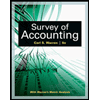SECURITY CHECK Income Statement For the Year Ended May 31, 2024 Product Line Industrial Systems Household Systems Total Net Sales Revenue S 360,000 $ 380,000 $ 740,000 Cost of Goods Sold: Variable 37,000 47,000 84,000 Fixed 260,000 63,000 323,000 Total Cost of Goods Sold 297,000 110,000 407,000 Gross Profit 63,000 270,000 333,000 Selling and Administrative Expenses: Variable 64,000 73,000 137,000 Fixed 44,000 26,000 70,000 Total Selling and Administrative Expenses 108,000 99,000 207,000 Operating Income (Loss) S (45,000) $ 171,000 $ 126,000
SECURITY CHECK Income Statement For the Year Ended May 31, 2024 Product Line Industrial Systems Household Systems Total Net Sales Revenue S 360,000 $ 380,000 $ 740,000 Cost of Goods Sold: Variable 37,000 47,000 84,000 Fixed 260,000 63,000 323,000 Total Cost of Goods Sold 297,000 110,000 407,000 Gross Profit 63,000 270,000 333,000 Selling and Administrative Expenses: Variable 64,000 73,000 137,000 Fixed 44,000 26,000 70,000 Total Selling and Administrative Expenses 108,000 99,000 207,000 Operating Income (Loss) S (45,000) $ 171,000 $ 126,000
College Accounting, Chapters 1-27
23rd Edition
ISBN:9781337794756
Author:HEINTZ, James A.
Publisher:HEINTZ, James A.
Chapter25: Departmental Accounting
Section: Chapter Questions
Problem 9SPA: INCOME STATEMENT WITH DEPART MENTAL DIRECT OPERATING MARGIN AND TOTAL OPERATING INCOME Durwood...
Related questions
Question
Help please... also for 2b.) $(41,000)

Transcribed Image Text:**Security Check: Income Statement for the Year Ended May 31, 2024**
This income statement provides a detailed breakdown of the financial performance for Security Check, specified by product lines: Industrial Systems and Household Systems. The statement includes figures for Net Sales Revenue, Cost of Goods Sold, Gross Profit, Selling and Administrative Expenses, and Operating Income for the fiscal year.
**Product Line Analysis:**
1. **Net Sales Revenue:**
- Industrial Systems: $360,000
- Household Systems: $380,000
- Total: $740,000
2. **Cost of Goods Sold:**
- **Variable Costs:**
- Industrial Systems: $37,000
- Household Systems: $47,000
- Total Variable Costs: $84,000
- **Fixed Costs:**
- Industrial Systems: $260,000
- Household Systems: $63,000
- Total Fixed Costs: $323,000
- **Total Cost of Goods Sold:**
- Industrial Systems: $297,000
- Household Systems: $110,000
- Total: $407,000
3. **Gross Profit:**
- Industrial Systems: $63,000
- Household Systems: $270,000
- Total Gross Profit: $333,000
4. **Selling and Administrative Expenses:**
- **Variable Expenses:**
- Industrial Systems: $64,000
- Household Systems: $73,000
- Total Variable Expenses: $137,000
- **Fixed Expenses:**
- Industrial Systems: $44,000
- Household Systems: $26,000
- Total Fixed Expenses: $70,000
- **Total Selling and Administrative Expenses:**
- Industrial Systems: $108,000
- Household Systems: $99,000
- Total: $207,000
5. **Operating Income (Loss):**
- Industrial Systems: $(45,000)
- Household Systems: $171,000
- Total Operating Income: $126,000
**Summary:**
The statement showcases the profitability of each product line, with Household Systems generating a significant operating income while Industrial Systems reported a loss. This financial document assists in evaluating the cost structures and profitability of different product segments within the company.

Transcribed Image Text:**Study on the Industrial Systems Product Line**
**Background:**
Members of the board are surprised that the industrial systems product line is not profitable. They commission a study to determine whether the company should drop the line. Company accountants estimate that dropping industrial systems will decrease the fixed cost of goods sold by $80,000 and decrease fixed selling and administrative expenses by $12,000.
**Requirements:**
1. **Differential Analysis:**
- Prepare a differential analysis to determine if Security Check should discontinue the industrial systems product line.
2. **Contribution Margin Income Statements:**
- Create contribution margin income statements to determine Security Check’s total operating income under two scenarios:
- (a) With the industrial systems line.
- (b) Without the industrial systems line.
- Compare the income differences between the two scenarios to your answer from the differential analysis in requirement 1.
Expert Solution
This question has been solved!
Explore an expertly crafted, step-by-step solution for a thorough understanding of key concepts.
This is a popular solution!
Trending now
This is a popular solution!
Step by step
Solved in 2 steps with 3 images

Knowledge Booster
Learn more about
Need a deep-dive on the concept behind this application? Look no further. Learn more about this topic, accounting and related others by exploring similar questions and additional content below.Recommended textbooks for you

College Accounting, Chapters 1-27
Accounting
ISBN:
9781337794756
Author:
HEINTZ, James A.
Publisher:
Cengage Learning,

Managerial Accounting: The Cornerstone of Busines…
Accounting
ISBN:
9781337115773
Author:
Maryanne M. Mowen, Don R. Hansen, Dan L. Heitger
Publisher:
Cengage Learning

Cornerstones of Cost Management (Cornerstones Ser…
Accounting
ISBN:
9781305970663
Author:
Don R. Hansen, Maryanne M. Mowen
Publisher:
Cengage Learning

College Accounting, Chapters 1-27
Accounting
ISBN:
9781337794756
Author:
HEINTZ, James A.
Publisher:
Cengage Learning,

Managerial Accounting: The Cornerstone of Busines…
Accounting
ISBN:
9781337115773
Author:
Maryanne M. Mowen, Don R. Hansen, Dan L. Heitger
Publisher:
Cengage Learning

Cornerstones of Cost Management (Cornerstones Ser…
Accounting
ISBN:
9781305970663
Author:
Don R. Hansen, Maryanne M. Mowen
Publisher:
Cengage Learning

Principles of Accounting Volume 2
Accounting
ISBN:
9781947172609
Author:
OpenStax
Publisher:
OpenStax College

Survey of Accounting (Accounting I)
Accounting
ISBN:
9781305961883
Author:
Carl Warren
Publisher:
Cengage Learning